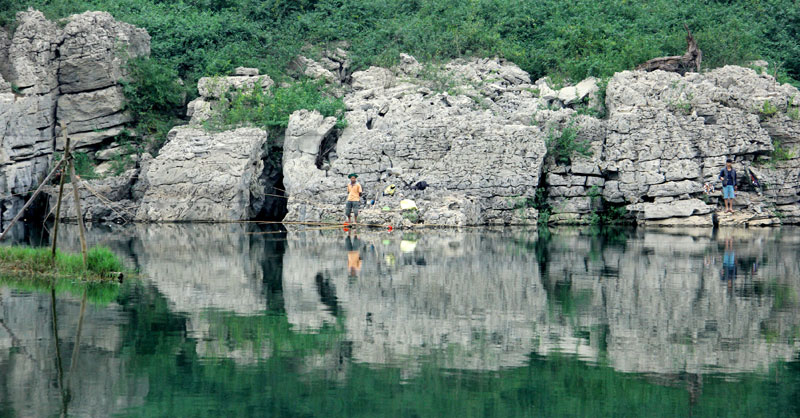
(HBO) - The land of Muong Bi - Tan Lac has the potential of "heaven treasure" to develop the types of ethnic cultural identities and ecological tourism in the area of Hoa Binh Lake. Two lakeside communes of Tan Lac - Ngoi Hoa and Trung Hoa - have romantic and beautiful sceneries, and Muong ethnic identity is also being kept here. The local people have built tourism products to meet the needs of tourists.

The poetic landscape of Trung Hoa commune
(Tan Lac) is a good advantage for the development of ecotourism in association with
the ethnic cultural identity.
Ngoi Hoa commune is the target of many
investment enterprises in tourism industry to run business. Ngoi village is a
long-standing village of Muong ethnic people, to be considered as one of the
most beautiful and primitive lakeside hamlet in the province. Ngoi Hoa Bay, Hoa
Tien Cave, Tien Lake, the beautiful and attractive primitive areas, wild
natural sceneries make an opportunity to build tourism products to meet the
needs of tourists.
Trung Hoa is a commune located in the
lakeside with many hamlets and villages preserving ethnic cultural identity.
The commune has wild natural landscapes, white limestone mountains full of
enchanting. Especially, there is a blue lake in the mountains, the scenery is
very poetic; all of which has made a good opportunity to exploit the
development of ecological and identity tourism, community – based tourism.
Hoa Binh Lake tourism development is a focus
of tourism development orientation of Tan Lac district. The district is
launching a project to preserve Muong ethnic cultural identity in association
with the development of a community tourism site in Ngoi village, Ngoi Hoa
commune. At the same time, the district has also concentrated on supporting the
investors to clear the surface of 435 Road (Binh Thanh - Thung Nai - Ngoi Hoa).
The province has agreed to invest in the road construction to Hoa Tien Cave
(Ngoi Hoa), connecting from Ngoi village to Ba Khan, towards to the entrance of
Hoa Tien Cave. When this route is put into operation, it will meet the
exploitation need of Hoa Tien Cave national scenic spot. The Department of Culture,
Sports and Tourism has investigated to build the road route from Ngoi Hoa -
Trung Hoa - Phu Vinh - Ba Khan (Mai Chau). In the first 6 months of 2018, the
district opened a training course of exploiting community homestay tourism
business for 30 households. The tourism activities have initially been
delighted, the number of tourists and the amount of tourism revenue have been
improved. In 2017, the total number of visitors to the district was 94.6
thousand people, which has increased by 12 thousand visitors compared with the
previous year, the tourism revenue reached at 10.9 billion VND, the income from
tourism reached at 17.7 billion VND. In the first six months of 2018, Tan Lac
district has been greeting 76 thousand visitors.
With an increasingly vibrant and widespread emulation movement aimed at building cultured residential areas and cultured families, Yen Thuy District has been making steady progress toward improving both the material and spiritual well-being of its people, while fostering a civilized, prosperous, beautiful, and progressive community.
Once lacking recreational spaces and community facilities, Residential Group 2 in Quynh Lam Ward (Hoa Binh City) has recently received attention for the construction of a new, spacious, and fully equipped cultural house. The project followed the model of state support combined with public contributions in both labor and funding.
The "All people unite to build cultural life" movement, which has been effectively integrated with Kim Boi district’s socio-economic development goals, is fostering a lively spirit of emulation across local residential areas, hamlets, villages, public agencies, and enterprises. In addition, through the initiative, traditional cultural values are being preserved and promoted, while community solidarity and mutual support in poverty reduction and economic development are being strengthened.
A working delegation of the Hoa Binh provincial People’s Committee led by its Permanent Vice Chairman Nguyen Van Toan on June 11 inspected the progress of a project to build the Mo Muong Cultural Heritage Conservation Space linked to tourism services in Hop Phong commune, Cao Phong district.
Born and growing in the heroic land of Muong Dong, Dinh Thi Kieu Dung, a resident in Bo town of Kim Boi district, in her childhood was nurtured by the sweet lullabies of her grandmother and mother. These melodies deeply imprinted on her soul, becoming an inseparable part of her love for her ethnic group's culture. For over 20 years, this love for her hometown has driven Dung to research, collect, and pass down the cultural values of the Muong people to future generations.
In the final days of May, the Ethnic Art Troupe of Hoa Binh Province organized performances to serve the people in remote, mountainous, and particularly disadvantaged areas within the province. These were not just ordinary artistic shows, but they were the meaningful journeys aimed at spreading cultural values, enhancing the spiritual life of the people and contributing to the preservation of ethnic minority cultural identities.



